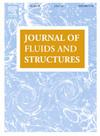Wave diffraction and radiation by a vertical cylinder standing near a floating elastic plate
IF 3.4
2区 工程技术
Q1 ENGINEERING, MECHANICAL
引用次数: 0
Abstract
Wave diffraction and radiation problems by a vertical cylinder standing near a floating elastic plate are considered. The linearized velocity potential theory is used to describe the fluid flow, and the thin elastic plate model is adopted for the elastic plate. The numerical solution procedure starts from dividing the fluid domain into two sub-domains, one below free surface and the other below the elastic plate. In the vertical direction, the velocity potential is expanded into a series of eigenfunctions based on separation of variables, which decomposes the three-dimensional problem into an infinite number of coupled two-dimensional problems in the horizontal plane. In the two sub-domains, each of two-dimensional problem is transformed into an integral equation. On the artificial vertical surface between two subdomains, an orthogonal inner product is applied for the eigenfunctions, and the edge conditions of elastic plate are satisfied. On the vertical surface of cylinder, similar inner product is adopted, and the boundary condition on the cylinder surface is imposed. A combined boundary element method and finite difference scheme is introduced to solve the integral differential equations numerically. Extensive results for the hydrodynamic force are provided and analyzed. It is found that the hydrodynamic force is highly oscillatory due to the complex interactions between cylinder and plate.
靠近浮动弹性板的垂直圆柱体的波衍射和辐射
研究了一个垂直圆柱体靠近浮动弹性板时的波衍射和辐射问题。流体流动采用线性化速度势理论,弹性板采用薄弹性板模型。数值求解过程首先将流体域划分为两个子域,一个在自由表面下,另一个在弹性板下。在垂直方向上,基于分离变量将速度势展开为一系列特征函数,将三维问题在水平面上分解为无数个耦合的二维问题。在两个子域中,将二维问题转化为积分方程。在两个子域之间的人工垂直表面上,对特征函数进行正交内积,得到弹性板的边缘条件。在圆柱体的垂直表面采用类似的内积,并在圆柱体表面施加边界条件。采用边界元法和有限差分格式相结合的方法对积分微分方程进行数值求解。提供并分析了水动力的广泛结果。研究发现,由于筒板之间复杂的相互作用,水动力具有高度的振荡特性。
本文章由计算机程序翻译,如有差异,请以英文原文为准。
求助全文
约1分钟内获得全文
求助全文
来源期刊

Journal of Fluids and Structures
工程技术-工程:机械
CiteScore
6.90
自引率
8.30%
发文量
173
审稿时长
65 days
期刊介绍:
The Journal of Fluids and Structures serves as a focal point and a forum for the exchange of ideas, for the many kinds of specialists and practitioners concerned with fluid–structure interactions and the dynamics of systems related thereto, in any field. One of its aims is to foster the cross–fertilization of ideas, methods and techniques in the various disciplines involved.
The journal publishes papers that present original and significant contributions on all aspects of the mechanical interactions between fluids and solids, regardless of scale.
 求助内容:
求助内容: 应助结果提醒方式:
应助结果提醒方式:


